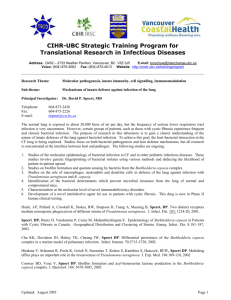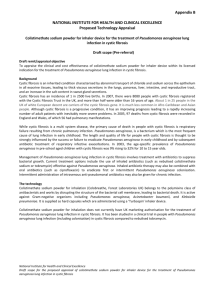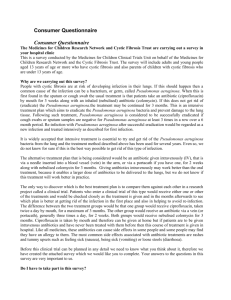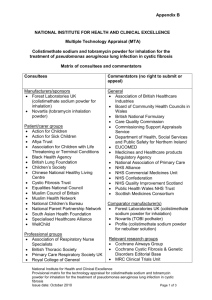(such as nebulised colistimethate sodium or tobramycin) effective
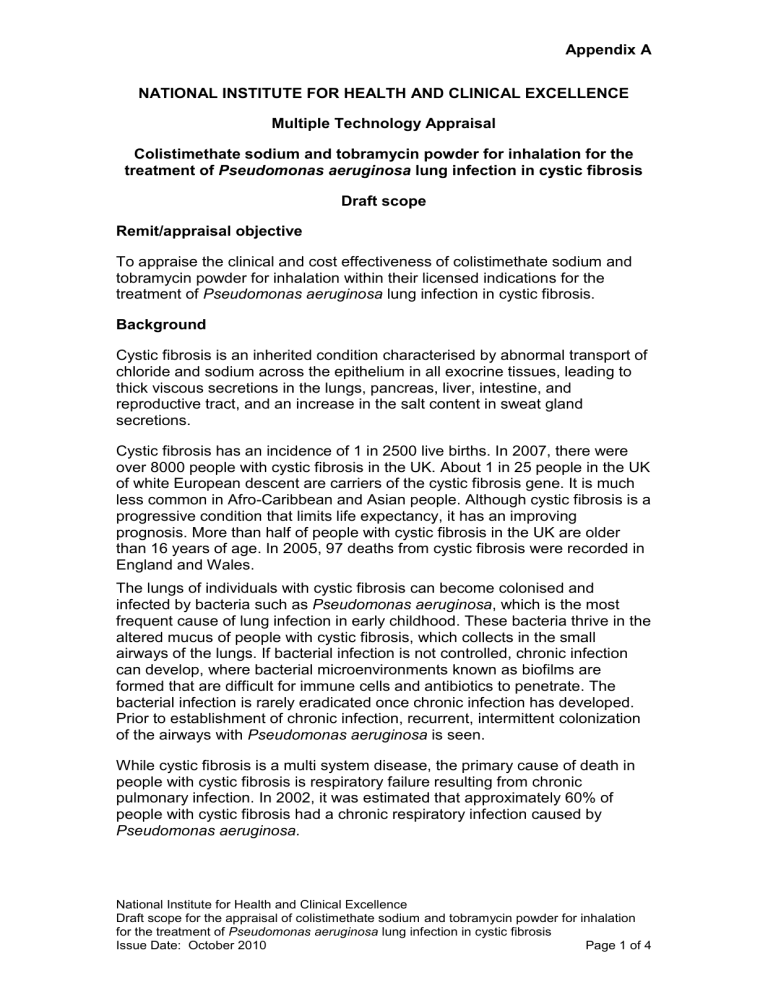
Appendix A
NATIONAL INSTITUTE FOR HEALTH AND CLINICAL EXCELLENCE
Multiple Technology Appraisal
Colistimethate sodium and tobramycin powder for inhalation for the treatment of Pseudomonas aeruginosa lung infection in cystic fibrosis
Draft scope
Remit/appraisal objective
To appraise the clinical and cost effectiveness of colistimethate sodium and tobramycin powder for inhalation within their licensed indications for the treatment of Pseudomonas aeruginosa lung infection in cystic fibrosis.
Background
Cystic fibrosis is an inherited condition characterised by abnormal transport of chloride and sodium across the epithelium in all exocrine tissues, leading to thick viscous secretions in the lungs, pancreas, liver, intestine, and reproductive tract, and an increase in the salt content in sweat gland secretions.
Cystic fibrosis has an incidence of 1 in 2500 live births. In 2007, there were over 8000 people with cystic fibrosis in the UK. About 1 in 25 people in the UK of white European descent are carriers of the cystic fibrosis gene. It is much less common in Afro-Caribbean and Asian people.
Although cystic fibrosis is a progressive condition that limits life expectancy, it has an improving prognosis. More than half of people with cystic fibrosis in the UK are older than 16 years of age. In 2005, 97 deaths from cystic fibrosis were recorded in
England and Wales.
The lungs of individuals with cystic fibrosis can become colonised and infected by bacteria such as Pseudomonas aeruginosa , which is the most frequent cause of lung infection in early childhood. These bacteria thrive in the altered mucus of people with cystic fibrosis, which collects in the small airways of the lungs. If bacterial infection is not controlled, chronic infection can develop, where bacterial microenvironments known as biofilms are formed that are difficult for immune cells and antibiotics to penetrate. The bacterial infection is rarely eradicated once chronic infection has developed.
Prior to establishment of chronic infection, recurrent, intermittent colonization of the airways with Pseudomonas aeruginosa is seen.
While cystic fibrosis is a multi system disease, the primary cause of death in people with cystic fibrosis is respiratory failure resulting from chronic pulmonary infection. In 2002, it was estimated that approximately 60% of people with cystic fibrosis had a chronic respiratory infection caused by
Pseudomonas aeruginosa.
National Institute for Health and Clinical Excellence
Draft scope for the appraisal of colistimethate sodium and tobramycin powder for inhalation for the treatment of Pseudomonas aeruginosa lung infection in cystic fibrosis
Issue Date: October 2010 Page 1 of 4
Appendix A
The length and quality of life for people with cystic fibrosis is thought to be strongly influenced by the success or failure to eradicate Pseudomonas aeruginosa in early childhood and by subsequent antibiotic treatment of respiratory infective exacerbations. In 2003, the age-specific prevalence of
Pseudomonas aeruginosa in pre-school aged children with cystic fibrosis was
9% rising to 32% for 10 to 15 year olds.
Management of Pseudomonas aeruginosa lung infection in cystic fibrosis involves treatment with antibiotics to suppress bacterial growth. Current treatment options include the use of inhaled antibiotics (such as nebulised colistimethate sodium or tobramycin) effective against Pseudomonas aeruginosa . Inhaled antibiotic therapy may also be combined with oral antibiotics (such as ciprofloxacin) to eradicate first or intermittent
Pseudomonas aeruginosa colonisation. Intermittent administration of intravenous anti-pseudomonal antibiotics may also be given for chronic infection.
The technologies
Colistimethate sodium powder for inhalation (Colobreathe, Forest
Laboratories UK) is a formulation of colistimethate sodium supplied as hard capsules which are administered using a ‘Turbospin’ inhaler device.
It.belongs to the polymixins class of antibacterials and works by disrupting the structure of the bacterial cell membrane, leading to bacterial death. It is active against Gram-negative organisms including Pseudomonas aeruginosa,
Acinetobacter baumanii, and Klebsiella pneumoniae.
Colistimethate sodium powder for inhalation does not currently have UK marketing authorisation for the treatment of Pseudomonas aeruginosa lung infection in cystic fibrosis. It has been studied in a clinical trial in people aged over 6 years old with Pseudomonas aeruginosa lung infection (including colonisation) in cystic fibrosis compared with nebulised tobramycin.
Tobramycin inhalation powder (Tobi Podhaler, Novartis) is a dry powder formulation of tobramycin that is inhaled directly into the lungs using an inhaler device. Tobramycin acts primarily by disrupting protein synthesis leading to altered cell membrane permeability, progressive disruption of the cell envelope and eventual cell death. Tobramycin inhibits protein synthesis of numerous Gram-negative bacteria and it is active against Pseudomonas aeruginosa .
Tobramycin inhalation powder does not currently have UK marketing authorisation for the treatment of Pseudomonas aeruginosa lung infection in cystic fibrosis. The Committee for Medicinal Products for Human Use (CHMP) has issued a positive opinion for tobramycin inhalation powder as a suppressive therapy for chronic infection due to Pseudomonas aeruginosa in people aged 6 years and older with cystic fibrosis.
National Institute for Health and Clinical Excellence
Draft scope for the appraisal of colistimethate sodium and tobramycin powder for inhalation for the treatment of Pseudomonas aeruginosa lung infection in cystic fibrosis
Issue Date: October 2010 Page 2 of 4
Intervention(s)
Population(s)
Comparators
Outcomes
Appendix A
Colistimethate sodium powder for inhalation
Tobramycin powder for inhalation
People aged 6 years and over with cystic fibrosis and intermittent Pseudomonas aeruginosa lung infection
And
People aged 6 years and over with cystic fibrosis and chronic Pseudomonas aeruginosa lung infection
Colistimethate sodium for nebulised inhalation
Tobramycin for nebulised inhalation
(Colistimethate sodium and tobramycin dry powder will also be compared with each other)
The outcome measures to be considered include:
Intermittent Pseudomonas aeruginosa infection:
eradication of the organism
lung function
time to subsequent infection
health-related quality of life
adverse effects of treatment
Chronic Pseudomonas aeruginosa infection
lung function
respiratory symptoms
frequency and time to acute exacerbations
body mass index
health related quality of life
adverse events of treatment (including rate of resistance to antibiotic treatment)
National Institute for Health and Clinical Excellence
Draft scope for the appraisal of colistimethate sodium and tobramycin powder for inhalation for the treatment of Pseudomonas aeruginosa lung infection in cystic fibrosis
Issue Date: October 2010 Page 3 of 4
Appendix A
Economic analysis The reference case stipulates that the cost effectiveness of treatments should be expressed in terms of incremental cost per quality-adjusted life year.
The reference case stipulates that the time horizon for estimating clinical and cost effectiveness should be sufficiently long to reflect any differences in costs or outcomes between the technologies being compared.
Costs will be considered from an NHS and Personal
Social Services perspective.
Other considerations
Related NICE recommendations
Guidance will only be issued in accordance with the marketing authorisation.
Consideration will be given to people with a disability who may not be able to manipulate inhaler devices.
Technology Appraisal in Prep aration, ‘Mannitol dry powder for inhalation for the treatment of cystic fibrosis. Publication date tbc.
Questions for consultation
What are the most appropriate antibiotics used for the treatment of
Pseudomonas aeruginosa lung infection in cystic fibrosis? Can they be nebulised?
Are there any subgroups of people in whom the technologies are expected to be more clinically effective and cost effective or other groups that should be examined separately?
Are there any issues that require special attention in light of the duty to have due regard to the need to eliminate unlawful discrimination and promote equality?
Is nutritional status an appropriate outcome? If so what are appropriate methods of assessment? Is BMI an appropriate outcome measure?
Do you consider the technology to be innovative in its potential to make a significant and substantial impact on health-related benefits and how it might improve the way that current need is met (is this a ‘step-change’ in the management of the condition)?
National Institute for Health and Clinical Excellence
Draft scope for the appraisal of colistimethate sodium and tobramycin powder for inhalation for the treatment of Pseudomonas aeruginosa lung infection in cystic fibrosis
Issue Date: October 2010 Page 4 of 4

